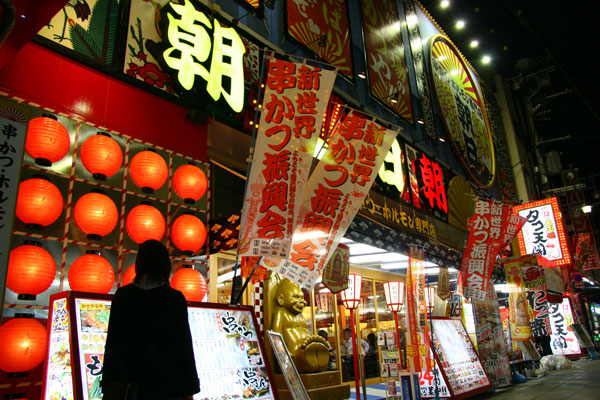
To me, Osaka is the Anti-Tokyo, in the same way that I consider Los Angeles to be the Anti-New York. No less metropolitan -- just entirely different. Osakans are less dressy than Tokyoites, stand on the opposite side of the escalator (standing on the right and walking on the left, like most of the world), and revere the aroma of caramelized Okonomiyaki sauce emanating from every street corner.
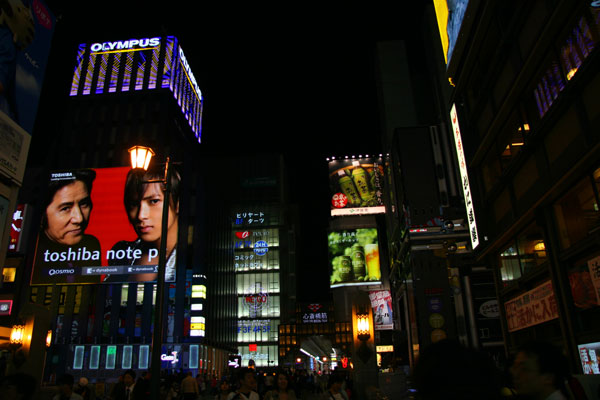
My favorite part of Osaka is the colourful, raucous alleys and semi-covered marketplaces known as Yokocho (side street). On any given day, droves of junior high students in blue and white school uniforms would brush past the washed-out facade of the neighbourhood Mahjong parlour while the oily smoke of Takoyaki (octobus balls) and Kushikatsu (deep-fried skewers) vendors compete for their business.
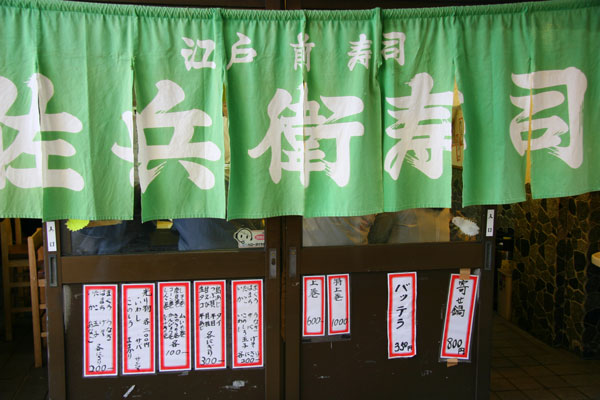
On any given day, you can find the old man occupying his favorite seat at the little sushi stall ...

... the younger crowd lining up outside the Kushikatsu stand ...

... and the teenagers who don't even bother with the inconvenience of sitting down to eat.
It's the most wonderful place to people-watch, and it just doesn't get much more authentically Osaka than this.
The Old New World of Shinsekai

Our hotel happened to be situated right beside one such Yokocho (no, this wasn't in our plan), part of a much larger neighbourhood known as Shinsekai. Shinsekai literally means "New World", a rather ironic name for an old, somewhat nostalgic and cheezy entertainment district. The Pedestrian streets are semi-obstructed by the huge bright menus of Kushikatsu restaurants, and the rows of souvenir stands selling Hello Kitty/Doraemon/Ultraman heads in Kushikatsu skewers targeting domestic tourists and local students.
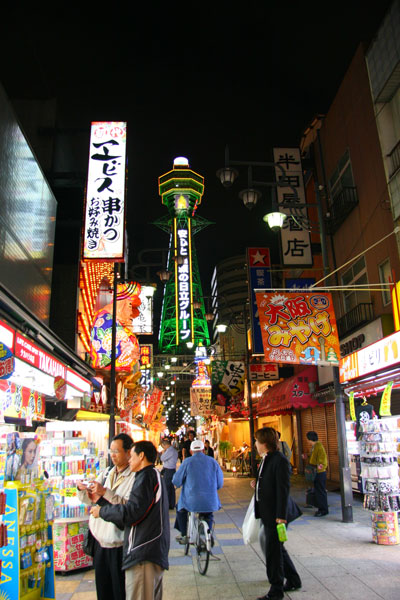
The south end of the area has spawned a large number of Pachinko parlours and cut-price business hotels (around 6000 yen (CAD$60) for a double room, and we stayed at one of them), while the north end stands THE symbol of old Osaka -- the Tsutenkaku (literally "Sky-reaching Manor"), which towers above its four-storey-tall neighbours in south Osaka yet no longer comparable to the cluster of skyscrapers at Umeda, Osaka's de-facto city centre just 5 kilometres to the north.

The Sankei Kurabu -- an old fashioned chess parlour -- would be a rare sight even for the Japanese. The sign at the top says "Shogi" (Japanese chess) and Igo (known in the Western world simply as "Go"). Note how jam packed it is even on a Monday afternoon. I wonder how it works ... how much money the players play for, and how the parlour operates (As a membership club? Or does it accept casual drop-ins?). All I could see were the player rankings on the walls and the signs for snacks like Kushikatsu and Doteyaki.

The original Zuboraya Honten, one of the most famous restaurants in Osaka specializing in ... well you don't need to be able to read Japanese to see what the speciality is. The huge Fugu (poisonous puffer fish) mascot is so well loved by the locals that you'll find all kinds of toys and souvenir items bearing its likeness. In case you're wondering, no we didn't have Fugu this time since May was not the best season -- the traditional season for Fugu starts in November or so, when the sea water temperature starts to drop. But the series of big white signs at the bottom of the picture advertising Tessa (Fugu sashimi) for 1200 yen (CAD$12) and Fugu Karaage (deep fried in batter) for 980 yen did make it a difficult decision for me. Fugu is an Osakan favorite after all, and I usually can't resist tasting the local food wherever I go.
You can read my review of a 6-course Fugu meal here, from my previous trip to Tokyo, if you're interested in having Fugu on your next trip.

At the end I couldn't resist the tempting pictures on the large outdoor menus of the Kushikatsu restaurants, so we walked around and proceeded to pick out restaurants that served BOTH Kushikatsu and Okonomiyaki (a kind of Japanese pancake with various toppings), two of the most representative local cuisines. We ended up picking this brightly lit restaurant with a huge menu list, and it turned out to be a VERY interesting experience. Surprisingly good food, spacious seats (actually the place was empty except for us), good service (which was expected since we were the only table). Everything went great until ...
The Yakuza (gangsters) walked in and demanded protection money! I am NOT joking ... the waiter had to come to our table to apologize to us afterwards. Four large-built males in early thirties came in and talked loudly at the waiters, who became very submissive. The manager wasn't in at the time, and the staff had to invite the visitors into the party room at the back. One of the waiters briefly went out (to get money? to fetch the manager?) and then rushed back. And at the end the visitors left, one of them visibly holding a small stack of cash.
Certainly not the kind of experience we anticipated, or welcome. But that is precisely one of the pleasures of travel. If you're STILL interested in my review of this restaurant's FOOD, it will be in the next article, entirely devoted to Osaka's local cuisines.
DIRECTIONS:
To get to Shinsekai, take the subway to the Dobutsuen-mae station, then just walk south. You absolutely can't miss the towering Tsutenkaku before you. The most interesting area, with the giant Fugu lantern and the high concentration of eateries and shops, lies to the immediate south of the Tsutenkaku.
Doguyasuji - More Than Just Kitchen Stuff

Whenever we go to Japan, my wife would demand that our itinerary includes a visit to one of these specialty "Dogu" streets for souvenir shopping. Tokyo has its 3-blocks-long Kappabashi Dogugai, and Osaka's equivalence is the Doguyasuji. Dogu simply means tools, so you can imagine that this is not a typical tourist street, but a place for food industry professionals and restauranteurs to order kitchen stoves, display cases, neon signs and the like. So what's so attractive about it?

Well, it's not just for the professionals -- you'll come across lots of really neat souvenirs you won't find anywhere else. There are a couple of these little shops selling handmade plastic food imitations. The price of 693 to 1029 yen for a piece of sushi is a little more expensive than what I remember of the same kind of stores in Tokyo. We didn't buy any this time -- we already spent enough last time (3000 yen) for a bowl of imitation ramen noodles.

Instead, this time we focused on Noren, or cloth dividers, which make beautiful decorations for the home. The sign here says 30% off regular price, but we're not really interested in these cartoon-looking ones.

We ended up buying this one for 3500 yen (CAD$35), shown here hanging in front of our kitchen.

If you've got a more colourful taste, you can take home a lantern made for Izakaya, Ramen, or Takoyaki vendors, fabric curtains for Sake vendors or lemonade stands, or a big Maneki Neko (fortune-beckoning cat) statue for good luck. Remember that the professionals shop here, so you're getting a good price on whatever you buy.
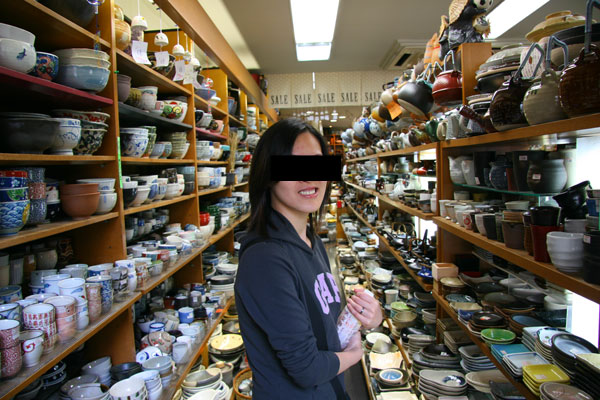
Bowls, cups, plates, teapots ... if you've got room in your luggage for some heavier items, the earthenware shops have handmade items from all over Japan. It was the beginning of our trip and we didn't want to carry heavy (and fragile!) items for the entire two weeks, so we relunctantly settled for chopsticks and chopstick setters. If it were the last day, crap ...
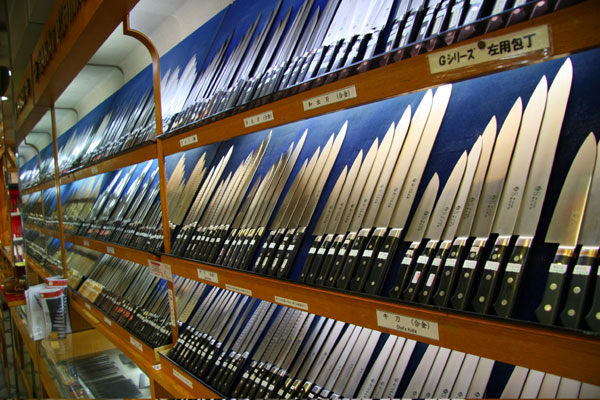
Japanese chefs are as serious about their knives as anyone, and if you've ever sat at the counter in front of a sushi chef, you'll appreciate how the metal's hardness affects the form of the food on your plate. So this is the place to be if you're interested in obtaining a better knife for your kitchen, even if you only use it for slicing breakfast sausages.

Well, there are serious knives, and then there are SERIOUS knives. And swords. And katanas. You can actually buy these real samurai swords, though you may have trouble getting through customs on your airplane back.
Whew. I must confess, I enjoy going to this place as much as my wife does.
DIRECTIONS:
Osaka's Doguyasuji is located conveniently just one block east of the Takashimaya department store in the popular shopping district of Namba. Take the subway to Namba, make your way southeast towards Takashimaya (write it down and ask anyone on the street...everyone knows Takashimaya). The Doguyasuji is at the next block to the east.
If you're going to Tokyo, Kappabashi Dogugai is located near the Tawaramachi subway station between the popular tourist districts of Asakusa and Ueno. Yes we've been there, and I remember it to be at least twice as long as Osaka's Doguyasuji, so happy shopping to you.
Kuromon Market - The Kitchen of Japan's Kitchen

One of Osaka's favorite nicknames is "Tenka no Daidokoro," or Japan's Kitchen, due to its position as the nation's major logistic hub and market centre for the past several centuries. By this rule, Osaka's largest market would be "Tenka no Daidokoro no Daidokoro." Without a doubt, the holder of this distinction would be the Kuromon Ichiba, the largest and favorite market of Osakans. Kuromon means "black gate," so you'll see black signs like these near the many entrances to the market.

The market itself is actually several blocks of covered walkway selling all kinds of fresh and cooked foodstuff, giving you a true understanding of what the Japanese REALLY eat, outside of restaurants. And you'll see that the market is appropriately dominated by vendors of vegetables, fish, and the wide varieties of Osaka's favorite snacks.

The local Miso (soybean paste) shop with its various kinds of Miso and Miso-derivatives. From the right: Amazake (sweet wine), "Spicy" and "Sweet" Kinzanji Miso and Moromi Miso (both are rather chunky types of Miso), and finally chunky white Miso used for marinating fish.
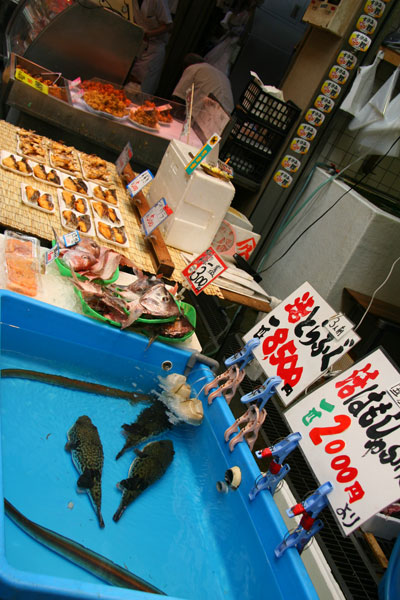
The chubby-looking fish is the famed Torafugu, one of the most expensive species of poisonous puffer fish. The small print says this size feeds three people, and sells for a whopping 8500 yen (CAD$85) each. For a less exquisite meal, Hamo (pike conger) sells for 2000 yen each. But for the typical house wife, you can't beat the price of 300 yen for a plate of random fish heads in those green containers in the middle.

For the lazier house wife, the tempura stand is an attractive option. Squid, squid tentacles, and sweet potatoes are 100 yen (CAD$1) each, a potato croquette costs 80 yen, and a large prawn costs 200 yen. Put a few of these in a toaster over and it's a cheap, fast meal.
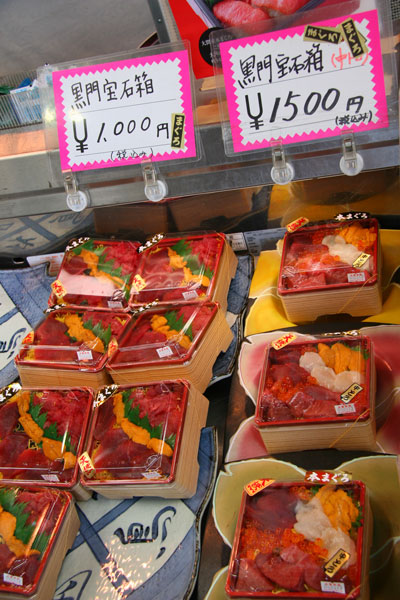
And for the really lazy ones, there's always ready-to-eat seafood rice boxes. 1000 yen (CAD$10) for the regular box with lean tuna, and for 500 yen more you get an upgrade with Chu-Toro (medium fatty tuna). Though, judging by the colour it doesn't look very fatty.

On a side street just outside the market, an old lady starts working on another cut at her grilled fish stand. Featuring prominently on her menu is "Yaki-dai", or grilled snapper. Note that if the two characters are swapped, "Tai-yaki" becomes baked snapper-shaped cake (which you can also find inside the market).

And of course, any Yokocho in Osaka won't be complete without a Takoyaki stand. The price of 300 yen (CAD$3) for 8 of these octopus balls is relatively cheap, as the going rate at the more famous chains is about 300-400 yen for 6. The 200 yen sign is for "tasty juice" (doesn't say what varieties of juice though), in case you're wondering.

Too bad we already had lunch, so we settled for some traditional Japanese confections. My wife's favorite is the simple Daifuku on the right, with its sweet azuki bean filling inside a mochi-rice dough. The one wrapped in an oak leaf is Kashiwa-mochi (literally "oak cake"). I don't remember much of the taste, so it couldn't have been that good.
DIRECTIONS:
The Kuromon Market is immediately southeast of the Nihombashi subway station. Even if you miss the English signs, you'll find it just by following the legions of house wives. Or if you're going to the Doguyasuji as well, it's just three large blocks to the east of the Doguyasuji.
Không có nhận xét nào:
Đăng nhận xét